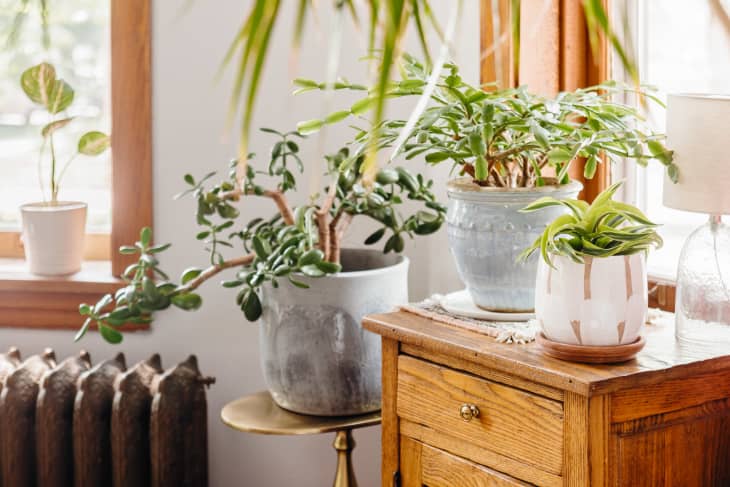The Sneaky Way Your Dirt Is Sabotaging Your Houseplants (and How to Fix It)

If you’ve ever hit up the soil section in your local nursery or hardware store, you know that the options are plentiful — and can be a little overwhelming. It feels like dirt should just be dirt, right? Sorry to say it, but the answer is no. Dirt is actually pretty complicated!
One thing it’s easy to get tripped up on at the store: Reaching for gardening soil rather than potting soil, which is an understandable mistake to make. While it sounds like it would do the trick for potted plants, gardening soil’s makeup is quite different from the makeup of potting soil. You’ll find that gardening soil is heavy with compost and does not drain well because it was not created for container or indoor gardening. Instead, gardening soil’s main purpose is to fill and supplement outdoor garden beds.
For many plants, a standard “potting soil” will do for any planting or repotting. But technically speaking, “potting soil” isn’t soil at all — and that’s one of the most important things to remember. It’s a mix of different mediums like perlite, peat, sphagnum moss, compost, vermiculite, and coco coir. The different ingredients in the mix make sure that the potting soil drains well and is high in nutrients. The ratio of these ingredients you’ll need depends on the type of plants you’re repotting.
If you swear you’re doing everything right but your plants are less than happy or have a tendency to develop root rot, it’s possible that your choice of potting soil might be sabotaging your plant’s health. Here’s how to know what to buy to make your houseplants happiest.
All-Purpose Potting Soil
This a cheaper, generic mix that almost every brand makes. You can use it for your houseplants and for outdoor container gardening. If you’re looking for a potting mix that you can use for multiple projects without worry, this is the one you want. But if your plants skew more toward the cactus and succulent family, there are better options.
Organic Potting Soil
Organic potting soil is made from all-natural plant- and animal-based materials. Typical ingredients include worm castings, compost, and other decaying plant matter. This mix gives an extra boost to the health of your plants. It’s also a necessity if you’re growing herbs or veggies and want them to remain organic throughout the growing season.
Moisture-Controlling Potting Soil
Some plant owners choose to use a moisture-controlling potting soil. This mix has chemically modified moisture-controlling pellets which keep the soil from drying out all the way, which allows the plant to continuously wick moisture into the roots. This seems like a good idea in theory, but it can also cause issues with root rot, fungi, and fungus gnats.
Seed Starting Mix
In springtime, you’ll see seed starting mix hit the shelves in all the nurseries and big box home improvement stores. Seed starting mix doesn’t provide many nutrients to plants, as it promotes growth in seedling roots. Avoid this potting soil if you’re not starting seeds — it won’t do much to help established plants.
Cactus Soil
Cacti and citrus potting “soil” is typically a mixture of regular potting mix and sand. Cacti, succulents, and citrus plants all need soil that drains extremely well, which is why the sand is introduced. Hack alert: If you’re an overwaterer, you can also utilize this potting mix with other plants.
Outdoor Potting Mix
The only real difference between this potting mix and the all-purpose potting mix is that it contains a high level of fertilizer, which can be very beneficial for outdoor growing. Be careful using this type of mix with sensitive tropical plants.
What to Do if You Don’t Have the Right Soil
If you’ve mistakenly used gardening soil instead of potting soil, or you’ve realized your plant needs a sandier mix than what you’ve given them, no worries — you’ll just need to repot. Remove the plant, clean off its roots and clean out the pot, then re-plant with the correct soil.
Can you modify a soil to fit your needs? Yes, in a pinch, if you start with the most basic potting soil, you can add all kinds of components to soil like fertilizer, sand, and compost, but remember: You can’t take anything away.
Many plant owners who are unhappy with the types of potting soil available to them mix their own potting mixes from scratch. While it can be more expensive because you’re purchasing individual components, it usually pays for itself tenfold with your plants’ health.
If you’re interested in leveling up your houseplant game and building your own soil-less mix, start by making a basic combination. Add equal parts coco coir, perlite, vermiculite, and peat in a container and give it a stir, then use. It’s as easy as that! You can modify the recipe depending on your specific plant’s needs.